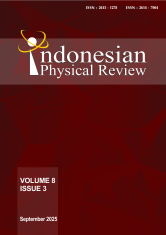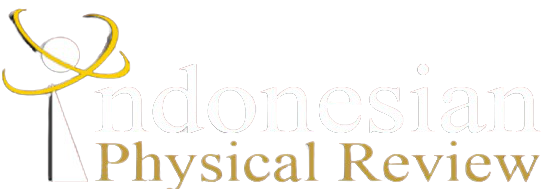IMPLEMENTATION OF AAPM TG-218 FOR PATIENT SPECIFIC QUALITY ASSURANCE (PSQA) IN THE CASE OF THORACIC TARGET REGION USING IMRT RADIOTHERAPY TECHNIQUE WITH EPID aSi-1200
DOI:
10.29303/ipr.v8i3.502Downloads
Additional Files
Abstract
The implementation of Patient-Specific Quality Assurance (PSQA) is crucial for ensuring the accuracy and safety of Intensity-Modulated Radiation Therapy (IMRT). This study evaluates the application of AAPM TG-218 recommendations in PSQA for thoracic region treatment using the IMRT technique. The study compares two PSQA methods, Perpendicular Composite (PC) and Perpendicular Field-by-Field (PFF), using Electronic Portal Imaging Device (EPID). Measurements were conducted on 10 IMRT patients using a Varian TrueBeam Linac and Eclipse TPS. The Gamma Index (GI) analysis with criteria 3%/3 mm, 3%/2 mm, and 2%/2 mm was used to assess dose distribution accuracy. The results indicate that the average Gamma Passing Rate (GPR) for 3%/2 mm criteria exceeded 95%, which is appropriate with AAPM TG-218 standards. However, stricter criteria (2%/2 mm) did not reach the minimum recommended values. The study suggests that PSQA using EPID with the PFF method under rotational gantry conditions is the most suitable approach for thoracic IMRT treatment verification. The local standardization recommendations from the results of this study can be used as a reference for determining methodological standards in cases of the thoracic region in the IMRT technique to increase efficiency in clinical applications with similar PSQA dosimetry.
Keywords:
Patient-Specific Quality Assurance AAPM TG-218 IMRT Gamma Index Electronic Portal Imaging Device Linac TrueBeamReferences
M. Miften et al., “Tolerance limits and methodologies for IMRT measurement-based verification QA: Recommendations of AAPM Task Group No. 218,†Med. Phys., vol. 45, no. 4, pp. e53–e83, Apr. 2018.
J. Deng, S. Y. Liu, Y. Huang, X. Li, and X. Wu, “Evaluating AAPM-TG-218 recommendations: Gamma index tolerance and action limits in IMRT and VMAT quality assurance using SunCHECK,†J. Appl. Clin. Med. Phys., vol. 25, no. 6, pp. 1–12, 2024.
L. Kumar, V. Kishore, M. Bhushan, P. Kumar, and G. Kumar, “Design and fabrication of a thoracic phantom for radiation dose verification in mega-voltage X-ray beam,†Mater. Today Proc., vol. 49, pp. 3050–3055, 2020..
E. Laugeman et al., “Comprehensive validation of halcyon 2.0 plans and the implementation of patient specific QA with multiple detector platforms.,†J. Appl. Clin. Med. Phys., vol. 21, no. 7, pp. 39–48, Jul. 2020.
I. A. Putu Inten Gayatri et al., “2-Dimensional IMRT dose audit: An Indonesian multicenter study,†Appl. Radiat. Isot., vol. 188, Oct. 2022.
S. Das, V. Kharade, V. Pandey, A. KV, R. K. Pasricha, and M. Gupta, “Gamma Index Analysis as a Patient-Specific Quality Assurance Tool for High-Precision Radiotherapy: A Clinical Perspective of Single Institute Experience,†Cureus, vol. 14, no. Dd, 2022.
K. Teichert et al., “Targeted multi-criteria optimisation in IMRT planning supplemented by knowledge based model creation,†Oper. Res. Heal. Care, vol. 23, p. 100185, 2019.
N. Matsushita, M. Nakamura, M. Sasaki, S. Yano, M. Yoshimura, and T. Mizowaki, “Analyses of integrated EPID images for on-treatment quality assurance to account for interfractional variations in volumetric modulated arc therapy,†J. Appl. Clin. Med. Phys., vol. 21, no. 1, pp. 110–116, 2020.
D. Tardi, A. Fitriandini, A. R. Fauziah, W. E. Wibowo, T. Siswantining, and S. A. Pawiro, “Analysis of dose distribution reproducibility based on a fluence map of in vivo transit dose using an electronic portal imaging device,†Biomed. Phys. Eng. Express, vol. 10, no. 1, p. 15013, 2024.
V. Mhatre, S. Pilakkal, P. Chadha, and K. Talpatra, “Dosimetric Comparison of a-Si 1200 and a-Si 1000 Electronic Portal Imager for Intensity Modulated Radiation Therapy (IMRT),†J. Nucl. Med. Radiat. Ther., vol. 09, no. 01, pp. 1–6, 2018.
T. Cui et al., “Improving intensity-modulated radiation therapy quality assurance by adopting statistical process control,†Cancer/Radiotherapie, vol. 26, no. 3, pp. 427–432, 2022.
Y. Xia, J. Adamson, Y. Zlateva, and W. Giles, “Application of TG-218 action limits to SRS and SBRT pre-treatment patient specific QA.,†J. radiosurgery SBRT, vol. 7, no. 2, pp. 135–147, 2020.
M. Ghazal, L. Södergren, M. Westermark, J. Söderström, and T. Pommer, “Dosimetric and mechanical equivalency of Varian TrueBeam linear accelerators,†J. Appl. Clin. Med. Phys., vol. 21, no. 12, pp. 43–53, Dec. 2020.
B. Dutta, S. Goswami, S. Moran, and P. Talukdar, “Commissioning and performance evaluation of varian truebeam linear accelerator,†J. Radiat. Med. Trop., vol. 4, no. 1, p. 25, 2023.
G. Antoniou, “Assessment of Adaptive Radiotherapy Workflows for Head and Neck Cancer,†University of Adelaide, 2022.
J. Rojas-López and D. Venencia, “Importance of beam-matching between truebeam stx and novalis tx in pre-treatment quality assurance using portal dosimetry,†J. Med. Phys., vol. 46, no. 3, pp. 211–220, 2021.
Y. Anetai et al., “Assessment of using a gamma index analysis for patient-specific quality assurance in Japan,†J. Appl. Clin. Med. Phys., vol. 23, no. 10, pp. 1–16, 2022.
S. Herwiningsih, P. Hanlon, and A. Fielding, “Sensitivity of an Elekta iView GT a-Si EPID model to delivery errors for pre-treatment verification of IMRT fields,†Australas. Phys. Eng. Sci. Med., vol. 37, no. 4, pp. 763–770, 2014.
S. Wang and Y. Zheng, “Evaluation and improvement of angular response for a commercial 2D detector array for patient-specific QA,†J. Appl. Clin. Med. Phys., vol. 24, no. 9, pp. 1–10, 2023.
S. S. Gay et al., “Dosimetric impact and detectability of multi-leaf collimator positioning errors on Varian Halcyon,†J. Appl. Clin. Med. Phys., vol. 20, no. 8, pp. 47–55, 2019.
L. Yu et al., “Analysis of dose comparison techniques for patient-specific quality assurance in radiation therapy,†J. Appl. Clin. Med. Phys., vol. 20, no. 11, pp. 189–198, 2019.
D. Perbangkara, Hendya; Pawiro, Supriyanto; Soejoko, “Karakteristik Electronic Portal Imaging Device (EPID) sebagai Dosimeter untuk Verifikasi IMRT dan VMAT,†Universitas Indonesia, Depok, 2016.
A. G. Ibrahim, I. E. Mohamed, and H. M. Zidan, “Dosimetric Comparison of Amorphous Silicon EPID and 2D Array Detector for Pre-Treatment Verification of Intensity Modulated Radiation Therapy,†Int. J. Med. Physics, Clin. Eng. Radiat. Oncol., vol. 07, no. 04, pp. 438–452, 2018.
W. Woon, P. B. Ravindran, P. Ekanayake, S. Vikraman, Y. Y. F. Lim, and J. Khalid, “A study on the effect of detector resolution on gamma index passing rate for VMAT and IMRT QA,†J. Appl. Clin. Med. Phys., vol. 19, no. 2, pp. 230–248, 2018.
L. Duan et al., “Evaluation of complexity and deliverability of IMRT treatment plans for breast cancer,†Sci. Rep., vol. 13, no. 1, pp. 1–10, 2023.
C. Stambaugh, J. Gagneur, A. Uejo, E. Clouser, and G. Ezzell, “Improvements in treatment planning calculations motivated by tightening IMRT QA tolerances,†J. Appl. Clin. Med. Phys., vol. 20, no. 1, pp. 250–257, 2019.
License

This work is licensed under a Creative Commons Attribution-NonCommercial-ShareAlike 4.0 International License.
Authors who publish with Indonesian Physical Review Journal, agree to the following terms:
- Authors retain copyright and grant the journal right of first publication with the work simultaneously licensed under a Creative Commons Attribution-ShareAlike 4.0 International Licence (CC BY SA-4.0). This license allows authors to use all articles, data sets, graphics, and appendices in data mining applications, search engines, web sites, blogs, and other platforms by providing an appropriate reference. The journal allows the author(s) to hold the copyright without restrictions and will retain publishing rights without restrictions.
- Authors are able to enter into separate, additional contractual arrangements for the non-exclusive distribution of the journal's published version of the work (e.g., post it to an institutional repository or publish it in a book), with an acknowledgment of its initial publication in Indonesian Physical Review Journal.
- Authors are permitted and encouraged to post their work online (e.g., in institutional repositories or on their website) prior to and during the submission process, as it can lead to productive exchanges, as well as earlier and greater citation of published work (See The Effect of Open Access).





